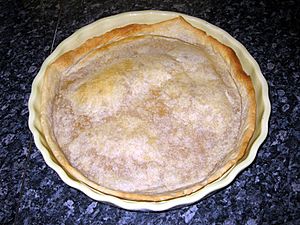Shortcrust pastry facts for kids

A shortcrust pastry pie crust
|
|
| Type | Pastry |
|---|---|
| Region or state | Western countries |
| Main ingredients | Fat (lard, shortening, butter or full-fat margarine), flour, water |
Shortcrust pastry is a popular type of pastry dough. It is often used to make the bottom or top crust of many tasty dishes. You can find it in tarts, quiches, and pies. This pastry works well for both sweet and savory foods. Think of delicious apple pie or a savory chicken pie!
To make shortcrust pastry, you usually need twice as much flour as fat by weight. The fat can be lard, shortening, butter, or margarine. First, the fat is mixed into the plain flour until it looks like breadcrumbs. Then, a small amount of cold water is added to bring the mixture together into a dough. This dough is then rolled out and shaped. Often, bakers use a mix of butter and lard. Butter adds a rich flavor, while lard helps make the pastry light and flaky.
Contents
Types of Shortcrust Pastry
There are a few different kinds of shortcrust pastry, each with its own special touch:
Pâte à Foncer: French Shortcrust
- Pâte à foncer is a French shortcrust pastry.
- It includes egg in the recipe.
- Butter and egg are mixed with a little sugar and salt first.
- Then, flour is added, and cold water helps bind it all together.
Pâte Brisée: Light and Delicate
- Pâte brisée is much like pâte à foncer.
- However, it uses more butter, making it lighter and more delicate.
- It can have up to three-fifths the amount of butter compared to flour.
- This type is often made without sugar, perfect for savory pies.
Pâte Sucrée: Sweet and Crumbly
- Pâte sucrée is also known as sweet crust pastry.
- It has more sugar, which makes it sweet and helps it break apart easily in your mouth.
- The sugar stops the gluten in the flour from becoming too strong.
- This creates a lovely, crumbly texture.
Pâte Sablée: Snappy and Dry
- Pâte sablée uses the same ingredients as pâte sucrée.
- But the way it's made is different: butter is creamed with sugar and eggs first.
- Then, the flour is gently mixed in.
- This method makes the butter spread more evenly.
- The dough puffs up less, creating a "snappy" and drier pastry.
- Sablée is great for sweet tarts, tea biscuits, and shaped cookies.
- It holds its shape well and doesn't usually need water.
How to Make Shortcrust Pastry
Making a good shortcrust pastry involves a few key steps to make sure it turns out flaky and tender.
Cutting the Fat into Flour
- When making shortcrust, the fat and flour are "cut" into each other.
- This means they are mixed until the fat is in small pieces, not fully blended.
- It's important to keep the ingredients cold.
- This helps the fat stay separate in the dough.
- When the pastry bakes, the cold fat melts and releases steam.
- This steam creates little pockets, making the crust flaky.
- Water is only added after the fat and flour are well combined.
- This helps coat the flour with fat, which stops too much gluten from forming.
- You can do this with a food processor, a special tool called a pastry blender, or even two knives.
Avoiding Overworking the Dough
- It's easy to overwork the dough, but you should try to avoid it.
- Overworking makes the gluten strands in the flour too long.
- This can make the pastry tough instead of light and crumbly.
- Bakers often use weak protein flour, like cake flour.
- This type of flour is less likely to become tough, even if worked a little more.
See also
 In Spanish: Masa quebrada para niños
In Spanish: Masa quebrada para niños

